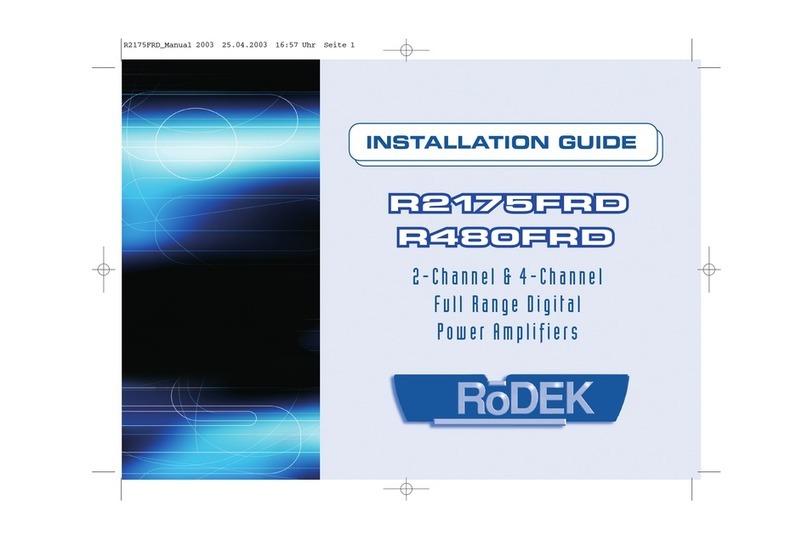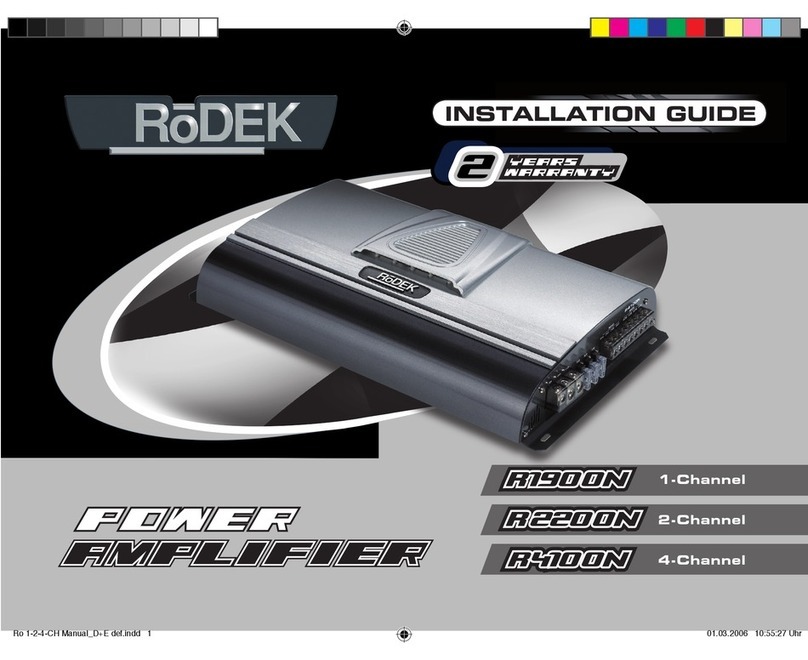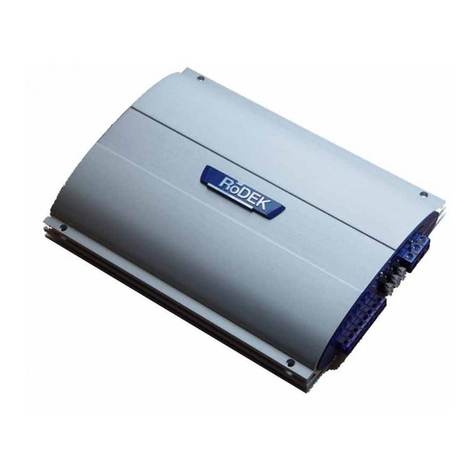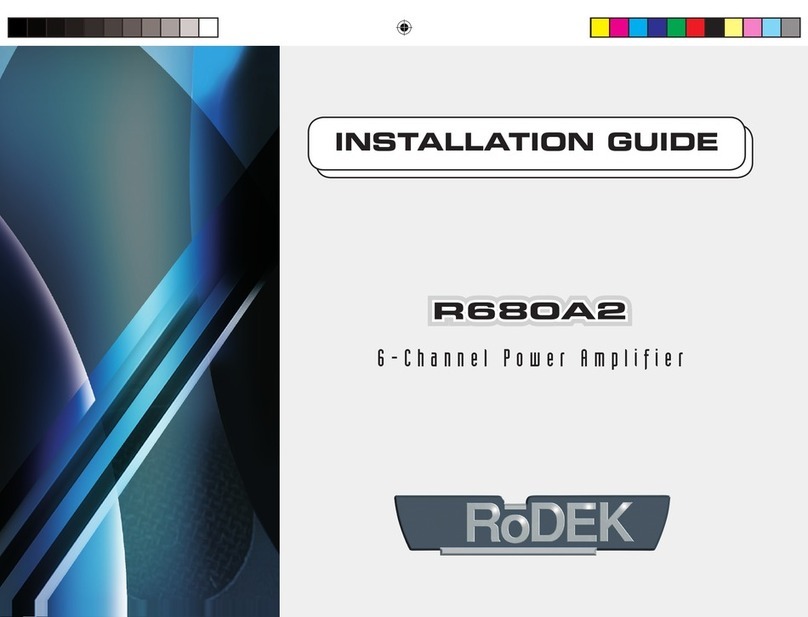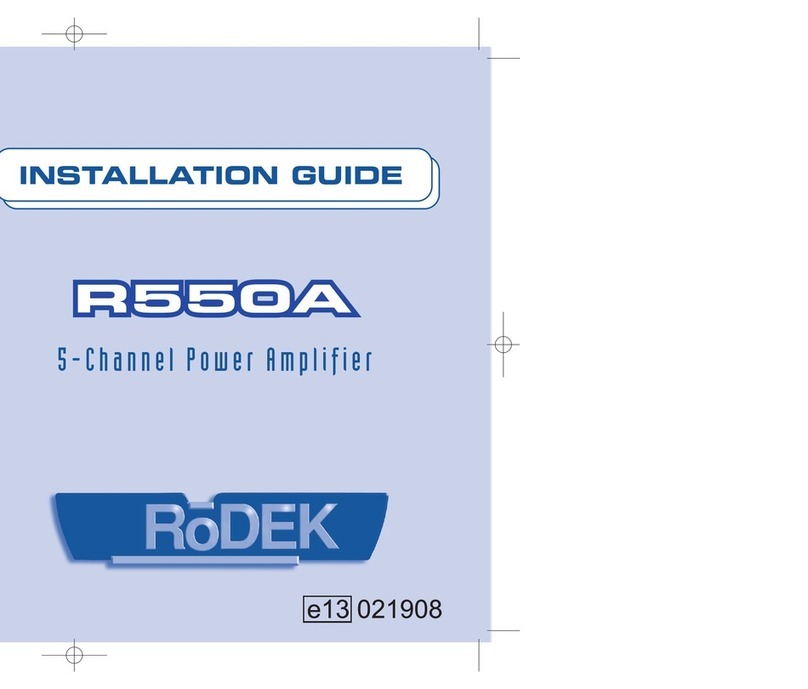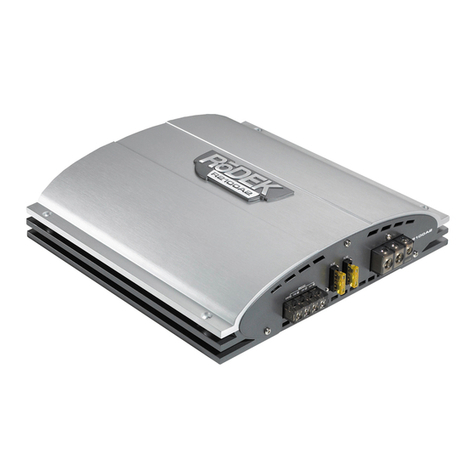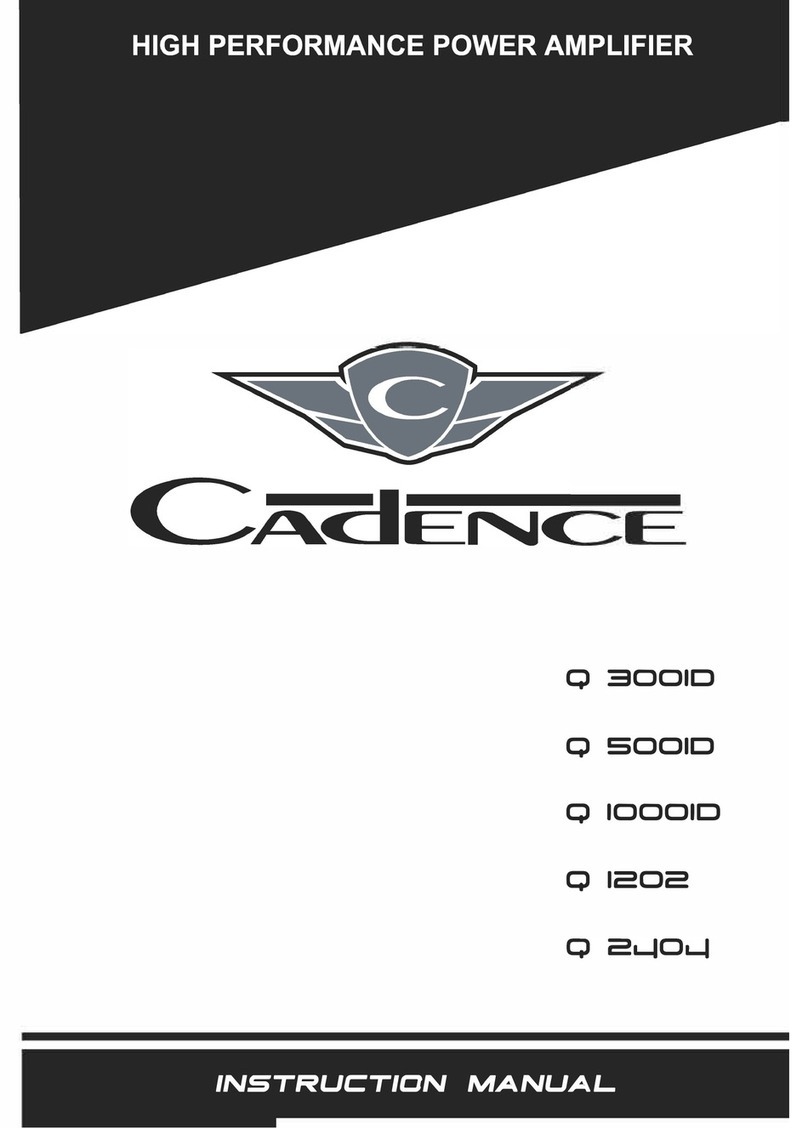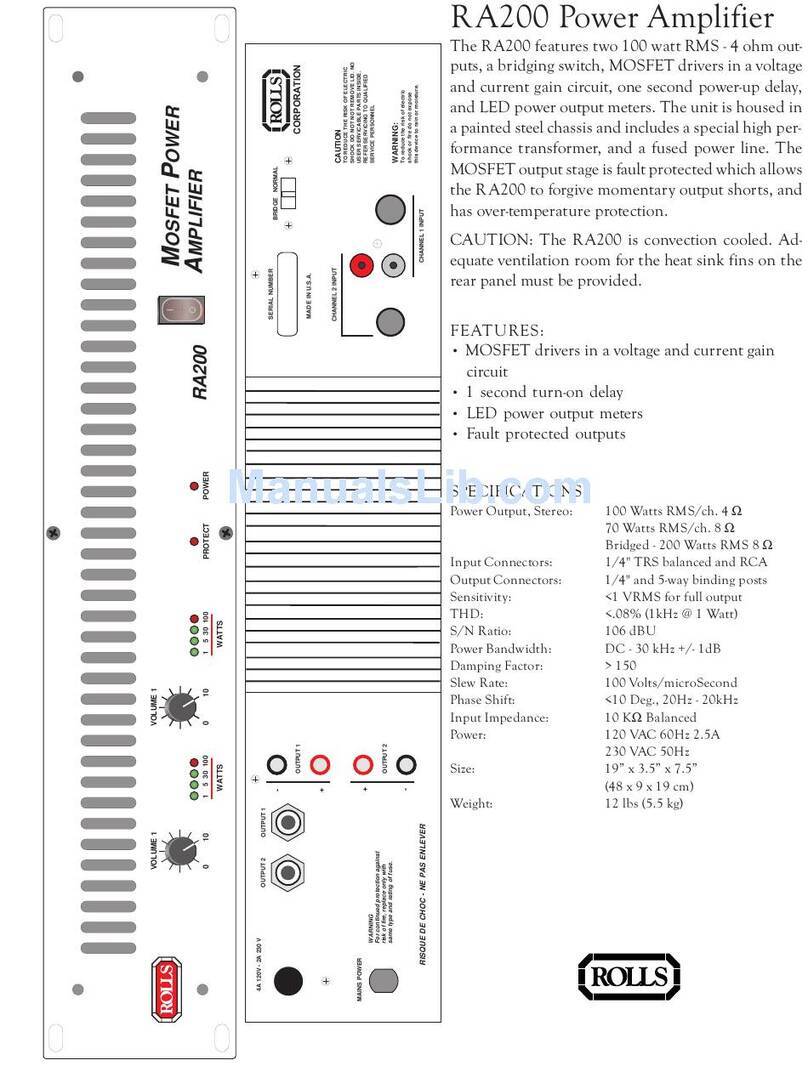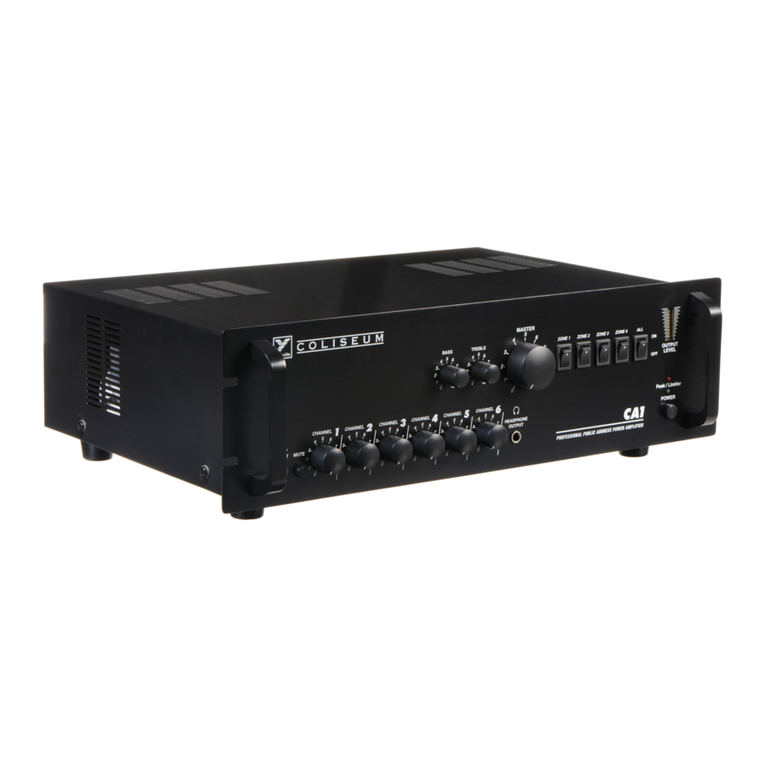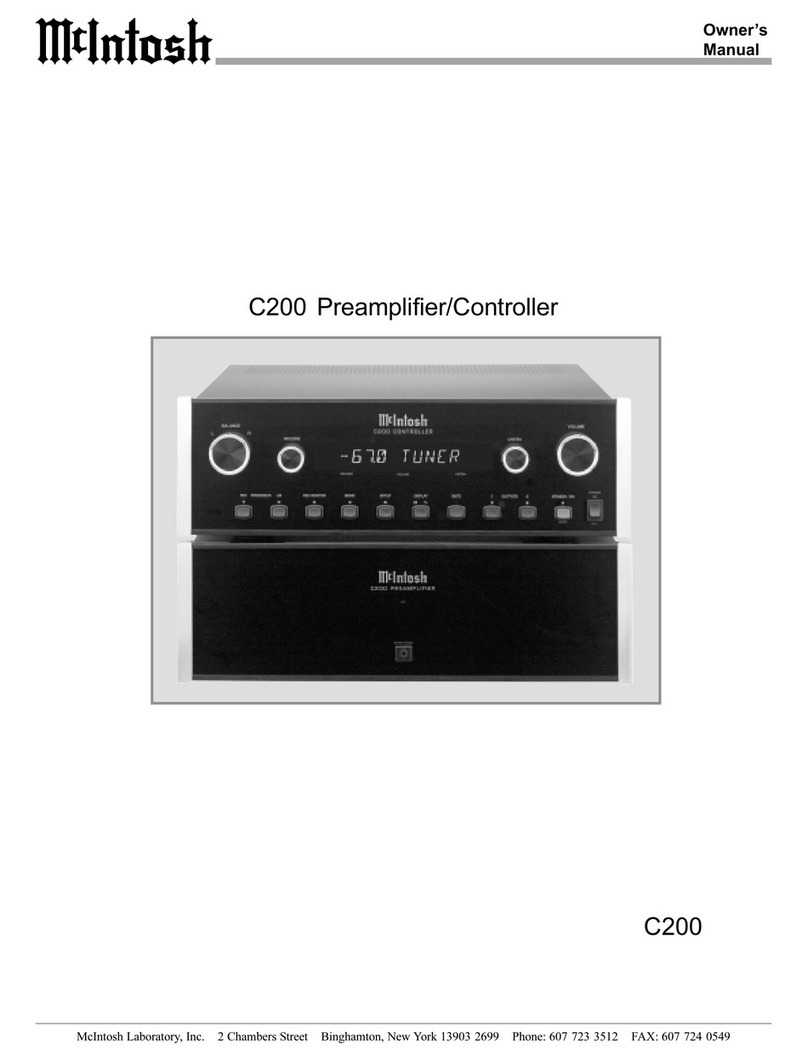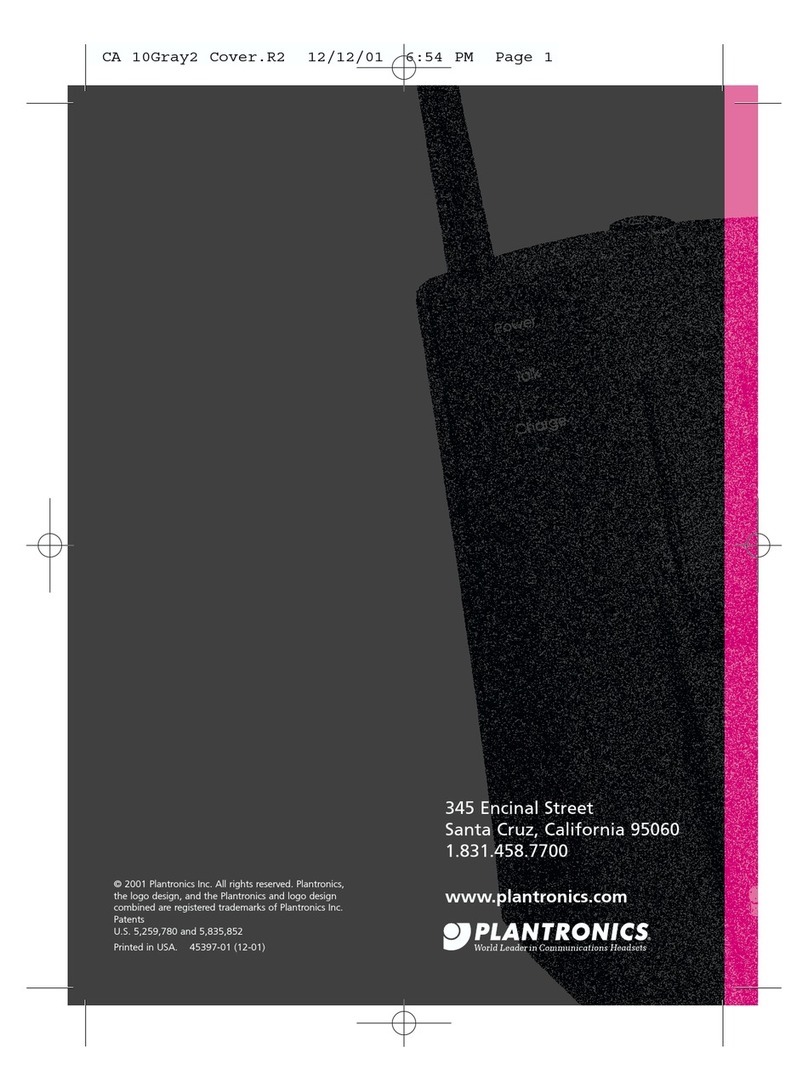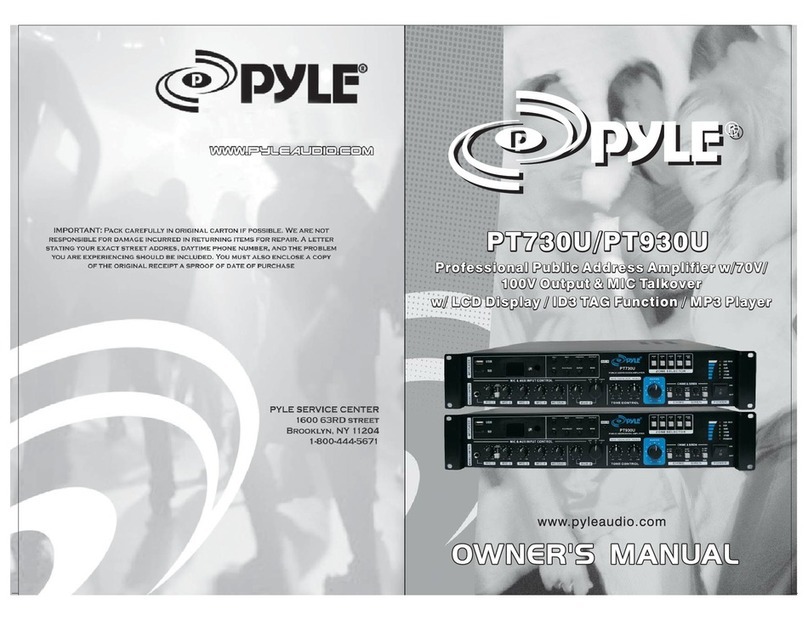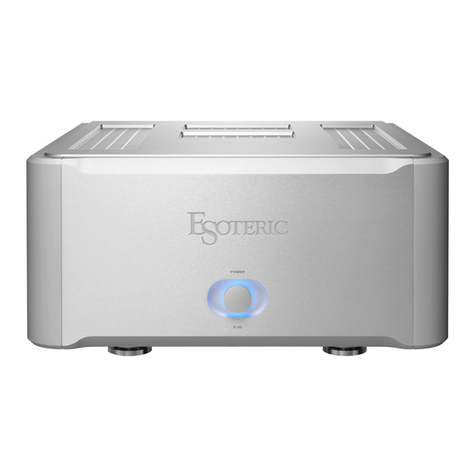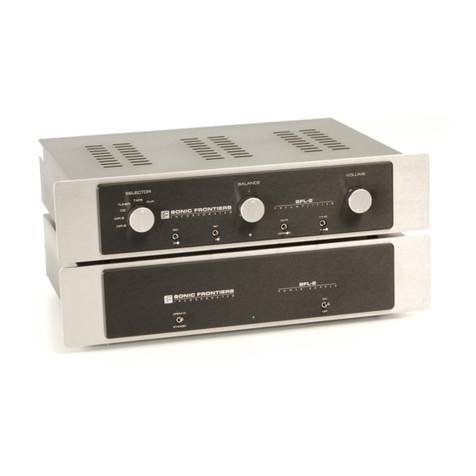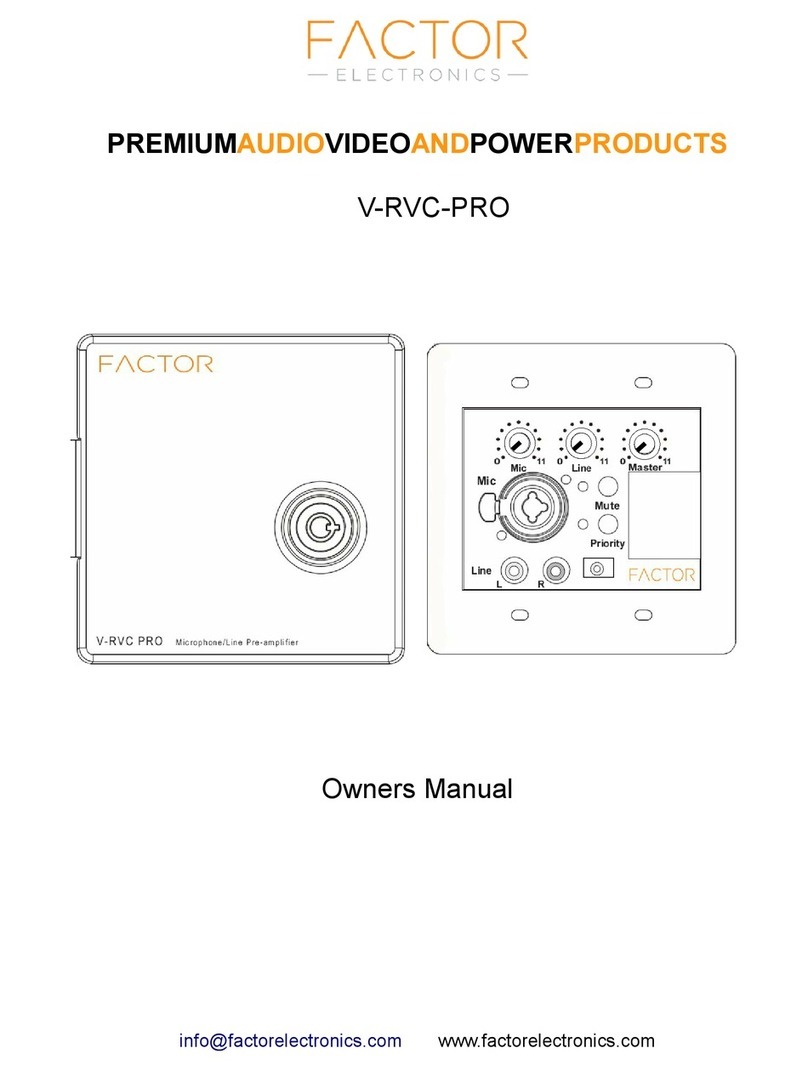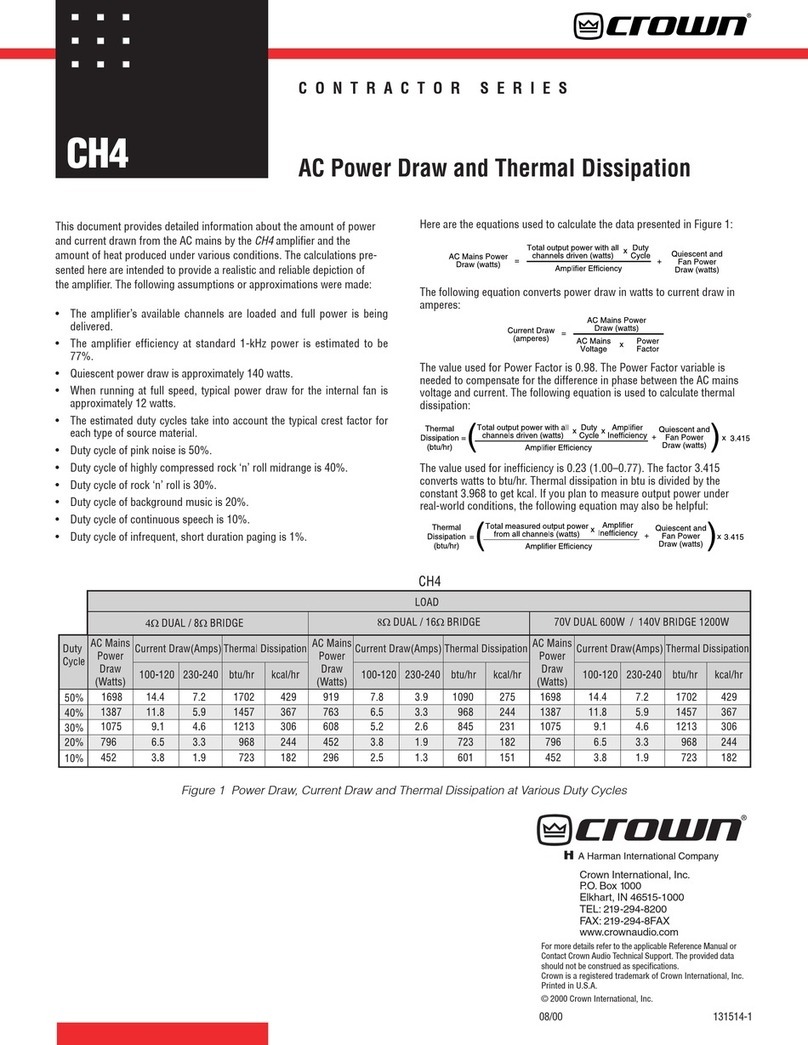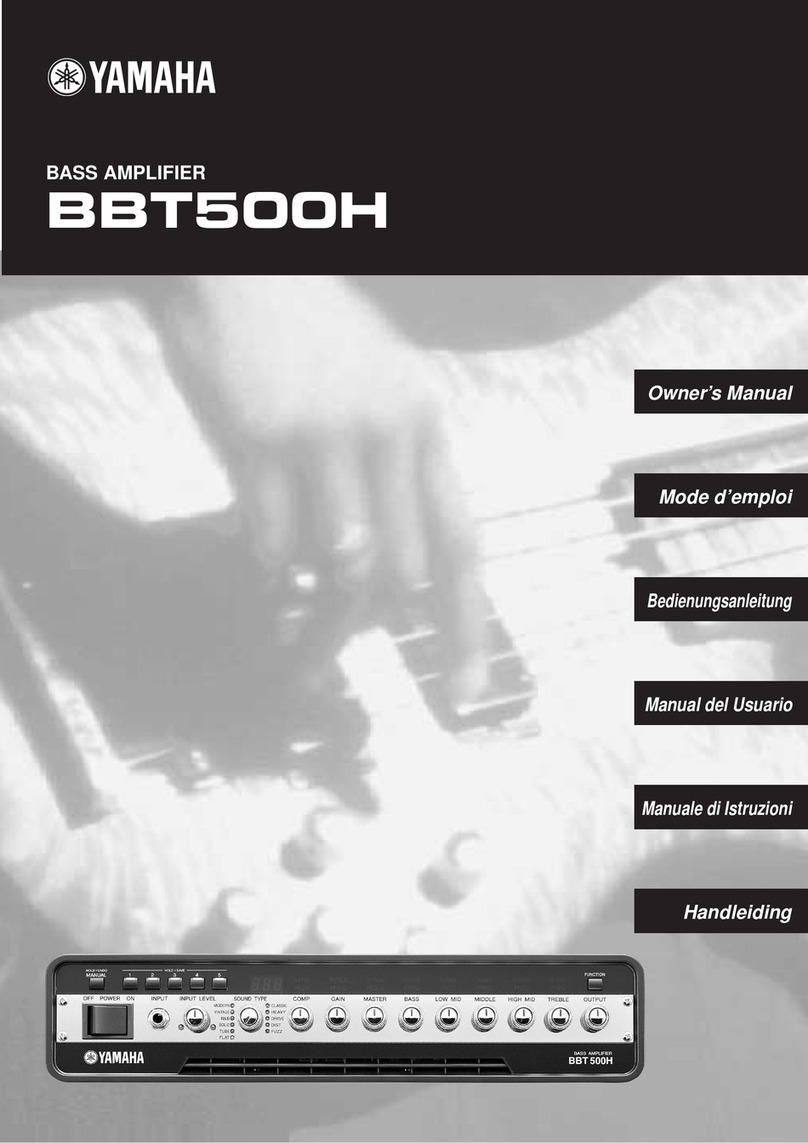RoDEK R680FRD User manual

6-Channel Full Range Digital
Power Amplifier
INSTALLATION GUIDE
R650FRD_Manual 2003 25.04.2003 17:11 Uhr Seite 1

R650FRD_Manual 2003 25.04.2003 17:11 Uhr Seite 2

INHALTSVERZEICHNIS / CONTENTS
1. TECHNISCHE MERKMALE. . . . . . . . . . . . . . . . . . . . . . . . . 5
2. EINGÄNGE -AUSGÄNGE -
BEDIENUNGSELEMENTE . . . . . . . . . . . . . . . . . . . . . . . . . . 6
3. GENERELLES ZUR MONTAGE . . . . . . . . . . . . . . . . . . . . . 8
3.1 WAHL DES EINBAUORTES . . . . . . . . . . . . . . . . . . . . . . . . 8
3.2 MONTAGE DESVERSTÄRKERS . . . . . . . . . . . . . . . . . . . 8
4. VERKABELUNG &ANSCHLUSS . . . . . . . . . . . . . . . . . . . 9
4.1 VERLEGEN DER CINCHKABEL & REMOTE-KABEL . 9
4.2 ANSCHLUSS DER LAUTSPRECHER-KABEL . . . . . . . 9
4.3 ANSCHLUSS DER POWER-KABEL . . . . . . . . . . . . . . . . 9
4.4 ERSTE FUNKTIONSPRÜFUNG. . . . . . . . . . . . . . . . . . . . 10
4.5 MINIMALE LASTIMPEDANZ. . . . . . . . . . . . . . . . . . . . . . 10
5. EINSTELLUNGEN &AKTIVWEICHE. . . . . . . . . . . . . . . 10
5.1 EMPFEHLUNGEN FÜR TRENNFREQUENZ-
EINSTELLUNGEN . . . . . . . . . . . . . . . . . . . . . . . . . . . . . . . . 11
5.2 EINSTELL-TIPPS. . . . . . . . . . . . . . . . . . . . . . . . . . . . . . . . . 11
5.3 ANPASSUNG DER EINGANGS-
EMPFINDLICHKEIT. . . . . . . . . . . . . . . . . . . . . . . . . . . . . . . 11
6.TECHNISCHE DATEN. . . . . . . . . . . . . . . . . . . . . . . . . . . . . . . 12
Seite Page
1. TECHNICAL FEATURES . . . . . . . . . . . . . . . . . . . . . . . . . . 14
2. INPUTS – OUTPUTS - CONTROLS . . . . . . . . . . . . . . . 15
3. MOUNTING OF THE AMPLIFIER . . . . . . . . . . . . . . . . . . 17
3.1 MOUNTING LOCATION . . . . . . . . . . . . . . . . . . . . . . . . . . 17
4. WIRING ROUTING & CONNECTION . . . . . . . . . . . . . . 18
4.1 ROUTING RCA INTERCONNECTS &
REMOTE LEAD . . . . . . . . . . . . . . . . . . . . . . . . . . . . . . . . . . . 18
4.2 CONNECTION OF LOUDSPEAKER CABLES . . . . . . 18
4.3 CONNECTION OF POWER CABLES. . . . . . . . . . . . . . . 19
4.4 POWERING UPTHEAMP . . . . . . . . . . . . . . . . . . . . . . . . . 19
4.5 MINIMUM IMPEDANCE LOAD . . . . . . . . . . . . . . . . . . . . 19
5. ADJUSTEMTS & SETTINGS . . . . . . . . . . . . . . . . . . . . . . 20
5.1 ACTIVE CROSSOVER ADJUSTEMENTS. . . . . . . . . . 20
5.2 RECOMMENDED CROSSOVER FREQUENCIES. . . . 20
5.3 ADJUSTEMENT OF INPUT GAIN . . . . . . . . . . . . . . . . . 20
6. TECHNICAL SPECIFICATIONS . . . . . . . . . . . . . . . . . . . 21
7. WARRANTY . . . . . . . . . . . . . . . . . . . . . . . . . . . . . . . . . . . . . 23
8. GARANTIEBESTIMMUNGEN . . . . . . . . . . . . . . . . . . . . . 23
9. GARANTIE-KARTE /WARRANTY-CARD. . . . . . . . . . 24
R650FRD_Manual 2003 25.04.2003 17:11 Uhr Seite 3

4
6-CHANNEL FULL RANGE DIGITAL POWER AMPLIFIER
Herzlichen Glückwunsch,
Wir gratulieren Ihnen zum Kauf der RODEK R650FRD Sechs-
kanal-Endstufe.
Ausgest attet mit einem kompromisslosen technischenAuf-
bau, setzt dieser Full Range DigitalVerstärker von RODEK
Maßstäbe bezüglich Kompaktheit, Leistungsabgabe, Klang-
qualität und Bedienungsfreundlichkeit.
Damit Sie dieWiedergabequalität und die Leistungsfähig-
keit diesesVerstärkers voll ausschöpfen können bitten wir
Sie, sich eingehend mit den Möglichkeiten und technischen
Features dieses Car-Amps vertraut zu machen. Lesen Sie
deshalb die nachfolgendenAbschnitte sorgfältig durch und
bewahren Sie diese Bedienungsanleitung für später auftau-
chende Fragen auf.
R650FRD_Manual 2003 25.04.2003 17:11 Uhr Seite 4

5
■Kompromissloser Aufbau und solide Konstruktion durch
den Einsatz von neuesten Schaltungstechniken und SMD
Bauteilen. Verwendung von hochwertigsten Materialien in
der Fertigung, wie z.B. doppelseitig kaschierte Glasfaser-
epoxydharzplatinen oder hochstromfähige, CNC gefräste
Blöcke für Strom- und Lautsprecheranschlüsse
■Intelligente Schutzschaltung, die Kurzschlüsse an den
Lautsprecherausgängen, Gleichspannung im Ausgangs-
signal und überhöhte Betriebstemperatur erkennt
■Betriebsanzeige mit zwei Status LED’s, welche Kurz-
schlüsse, elektrische- und thermische Überlastung des
Vers tärkers und Gleichspannung an den Anschlussklem-
men anzeigen.
■6-Kanal Verstärker zur Realisierung eines einbaufreund-
lichen und klangstarken 5/6-kanaligen System-Konzeptes,
z.B. bestehend aus zwei Paar Komponentenlautsprecher
(Front- und Heckbereich) und einem Subwoofer (Koffer-
raum), oder 6-kanalig mit zwei Paar Kompo-Systemen und
zwei 16er Kickbässen
■DigitalerVollbereichs-Verstärker mit extrem hohemWir-
kungsgrad und entsprechend kleinem Strombedarf. Bezo-
gen auf die Ausgangsleistung sehr kompakte Aussen-
Abmessungen.
■Zwei MOSFET-Netzteile sorgen für üppige Leistungsbe-
reitschaft
■Die 2 Ohm-Stabilität aller Kanäle bewirkt im Zusammen-
spiel mit dem exzellenten Dämpfungsfaktor enorme Lei-
stungsreserven und absolute Kontrolle der angeschlosse-
nen Lautsprecher
1. TECHNISCHE MERKMALE
R650FRD_Manual 2003 25.04.2003 17:11 Uhr Seite 5

6
2. EINGÄNGE - AUSGÄNGE - BEDIENUNGSELEMENTE
FRONT PANEL
R650FRD
REAR PANEL
R650FRD
R650FRD_Manual 2003 25.04.2003 17:11 Uhr Seite 6

7
2. EINGÄNGE - AUSGÄNGE - BEDIENUNGSELEMENTE
7. Status-LED’s "POWER + PROTECTION" signalisie-
ren den Betriebszustand desVerstärkers
8. Power InputTerminal "GND" für denAnschluss desVer-
stärkers an die Fahrzeug-Masse des Kfz’s
9. Power InputTerminal "REM" (Remote) für denAnschluss
desVerstärkers an den Remote-Ausgang des Headunits
10. Power InputTerminal "+ 12 V" für den Anschluss des
Vers tärkers an den Pluspol der Autobatterie
11. „SPEAKER OUTPUT“ Lautsprecher-Terminals, für
denAnschluss von 4 oder 2 Ohm Lautsprecher, bzw. für den
gebrückten Anschluss von Systemen mit mindestens 4 Ohm
Impedanz
12. Sicherungen (Mini-ATC Sicherungen, nicht abgebildet
da auf der Unterseite der Endstufe) für die interneAbsiche-
rung desVerstärkers gegen Überlastung und Fehlmanipula-
tion.Verwenden Sie für dieses Modell nur Sicherungen mit
25 AWert
1. Cinch Eingangsbuchsen LINE INPUT („1CH/2CH“)
jeweils für den linken und rechten Kanal. NF-Signal Eingän-
ge für den Anschluss an die Cinch-Ausgänge des Steuer-
gerätes
2. Cinch Eingangsbuchsen LINE INPUT („3CH/4CH“)
jeweils für den linken und rechten Kanal. NF-Signal Eingän-
ge für den Anschluss an die Cinch-Ausgänge des Steuer-
gerätes
3. Cinch Eingangsbuchsen LINE INPUT („5CH/6CH“)
jeweils für den linken und rechten Kanal. NF-Signal Eingän-
ge für den Anschluss an die Cinch-Ausgänge des Steuer-
gerätes
4. Eingangsempfindlichkeitsregler der drei Kanalpaare
(„1/2CH LEVEL“) für die Eingansempfindlichkeits-Anpas-
sung
5. Eingangsempfindlichkeitsregler der drei Kanalpaare
(„3/4CH LEVEL“) für die Eingansempfindlichkeits-Anpas-
sung
6. Eingangsempfindlichkeitsregler der drei Kanalpaare
(„5/6CH LEVEL“) für die Eingansempfindlichkeits-Anpas-
sung
R650FRD_Manual 2003 25.04.2003 17:11 Uhr Seite 7

8
3. GENERELLES ZUR MONTAGE
3.2 MONTAGE DES VERSTÄRKERS
Halten Sie denVerstärker an den gewünschten Ort und mar-
kieren Sie mit einem geeigneten Filzstift die Bohrposition
der vier Befestigungslöcher.
Bohren Sie die angezeichneten Löcher mit einem 2,5 oder 3
mm Bohrer.
Drücken Sie die beigelegten rechteckigen Gummifüße in die
Befestigungslöcher IhresVerstärkers!! Ein Masseschluss,
also Kontakt desVerstärkergehäuses mit der Kfz-Masse muss
unbedingt vermieden werden! Die Gummifüße isolieren den
Vers tärker und verhindern dadurch Brummschleifen. Legen
Sie denVerstärker auf die vorgebohrten Löcher und schrau-
ben denVerstärker durch anziehen der Schrauben über’s
Kreuz gleichmäßig an.
Sollte es nicht möglich sein, denVerstärker direkt auf eine
vorhandene ebene Fläche zu montieren kann es notwendig
werden, eine Zwischenplatte aus MDF anzufertigen.
Bevor Sie mit der Montage beginnen, erstellen Sie am be-
sten eine kurze Anschluss- und Installationsskizze. Be-
achten Sie bitte, dass die Kabelführung und der gewählte
Massepunkt einen entscheidenden Einfluss auf das störungs-
freie Funktionieren Ihrer Anlage hat.
BesondereAufmerksamkeit verdient auch die korrekte Plat-
zierung desVerstärkers (ausreichende Luftzufuhr!), sowie
die Qualität des verwendeten Zubehörs zur fachgerechten
Installation (Stromkabel, Cinchkabel, Sicherungshalter,Ver-
teilerblöcke, etc).
3.1 WAHL DES EINBAUORTES
DerVerstärker muss unbedingt gut plaziert, und im Interes-
se der passiven Sicherheit stabil befestigt werden. Prüfen
Sie, ob die gewählte Montagefläche eben und stabil genug
zur sicheren Befestigung desVerstärkers ist.
Als Montageort eignet sich z.B. ein Platz im Kofferraum oder
unter dem Fahrer- oder Beifahrersitz, bzw. jeder andere
Ort, der eine saubere Installation ermöglicht.
Stellen Sie eine ausreichende Belüftung respektive Kühlung
der Endstufe sicher (mindestens 5 cm Freiraum oberhalb und
auf den Seiten der Alu-Kühlkörpers).
Vermeiden Sie Montageorte mit "unbekanntem Hintergrund".
Es könnten sich ein Benzintank, hydraulische Bremsleitun-
gen, Kabel etc. dahinter verbergen! Achten Sie auch auf ei-
nen trocken, gegen mechanische Einwirkungen geschützten
Installationsort, der auch nach der Endmontage noch für die
Einstellung (z.B. der Eingangsempfindlichkeit) desVerstär-
kers gut zugänglich ist.
R650FRD_Manual 2003 25.04.2003 17:11 Uhr Seite 8

9
4. VERKABELUNG & ANSCHLUSS
Anschließend stecken Sie die Cinchkabel in die Cinchein-
gangsbuchsen desVerstärker ein.
4.2 ANSCHLUSS DER LAUTSPRECHER-
KABEL
Verwenden Sie Lautsprecherkabel mit 1.5 mm2bis 2.5 mm2
Querschnitt.
Für den Anschluss amVerstärker benötigen Sie einen In-
bus-Schlüssel und eineAbisolierzange. Entfernen Sie ca. 8
mm der Isolierung des LS-Kabels und beachten Sie die kor-
rekte Polung der Lautsprecherkabel (Plus auf Plus, Minus
auf Minus) beimAnschluss an dasTerminal. Ziehen Sie alle
LS-Schraublemmen satt an.
4.3 ANSCHLUSS DER POWER-KABEL
Verlegen Sie nun das Pluskabel direkt von der Batterie zum
Vers tärker. Innerhalb der ersten 30 cm nach dem Pluspol-
klemmenabgriff muß eine Hauptsicherung angebracht wer-
den. Die Haupt-Sicherung dient nur zur Absicherung des
Pluskabels gegen Kurzschluss auf Fahrzeug-Masse und dem
dadurch ev. resultierenden Kabelbrand (Vorschrift der Kfz-
Vers icherungen!!)
Verwenden Sie eine dem Stromkabelquerschnitt entspre-
chende Sicherung (mindestens jedoch 60A).
■Verwenden Sie beim Einziehen der Stromkabel entspre-
chende Kabeltüllen aus Gummi, um ein Durchscheuern an
Blechkanten, respektive den dadurch resultierenden Kurz-
schluss auf Chassismasse zu vermeiden!
ACHTUNG! Entfernen Sie vor Beginn der Arbeiten
immer das Massekabel vom Minuspol der Batterie !!
Bei allen nachfolgend beschriebenen Installations-
schritten muss der Stromkreis zur Batterie im Kraft-
fahrzeug unterbrochen sein! Erst nach Abschluß al-
ler Installationsarbeiten darf der Stromkreis wieder
geschlossen werden.
Info’s zum Stromkabelquerschnitt: Der Stromkabelquer-
schnitt der Plus- und Minus Hauptleitung (bei einer Kabellänge
von ca. 5m) sollte 16 bis 20 mm2betragen.
Dieser Stromkabel-Querschnitt garantiert eine problemlo-
se Funktion des Verstärkers, sowie auch die volle Lei-
stungsabgabe. Bei zu gering gewähltem Hauptstromkabel-
Querschnitt kann es zur übermäßigen Erhitzung desVer-
stärkers kommen.
4.1 VERLEGEN DER CINCHKABEL &
REMOTE KABEL
Verlegen Sie das/die Cinchkabel und auch das Remote-Ka-
bel vom Steuergerät zur Endstufe. Diese Kabel müssen rä-
umlich getrennt von der Stromzuführung desVerstärkers ein-
gezogen werden, ansonsten drohen Störungen derWieder-
gabe wie z.B.Alternatorpfeifen.Verwenden Sie mindestens
doppelt oder besser dreifach geschirmte Cinch-Kabel!
Schließen Sie das Remote-Kabel an das mit "Antenna-Rem."
oder "Amplifier-Rem." bezeichnete Kabel Ihres Steuergerätes
an. Das Remote-Kabel führt eine 12V Schaltspannung, die
denVerstärker einschaltet, wenn Sie das Steuergerät akti-
vieren.
R650FRD_Manual 2003 25.04.2003 17:11 Uhr Seite 9

10
Dieser RODEKVerstärker verfügt nicht über integrierte ak-
tive Frequenzweichen.
Mit einer einzigen Endstufe kann z.B. ein vollständiges
Passiv- oder Aktiv-System mit zwei unabhängigen Stereo-
Satelliten-Paaren (mit min. 4 Ohm Impedanz) für vorn und
hinten und einem getrennten Subwoofer angesteuert wer-
den. Um den angeschlossenen Lautsprechern ihren spezifi-
schen Übertragungsbereich zuzuweisen, bedarf es einer zu-
sätzlichen externen aktiven Frequenzweiche, oder aber ei-
nes Headunits mit eingebautem DSP und entsprechenden
Aktivweichen-Funktionen.
Die nachfolgenden Angaben stellen Anhaltspunkte für die
generelle Einstellung der externen Geräte dar, denn die
Filterung des Musiksignals muss beiVerwendung der R650FRD
vor der Einspeisung in die Endstufe erfolgen. Entweder mit
einer externenAktivweiche, oder aber mittels eines Hea-
dunits, das über entsprechendeWeichenfunktionen per in-
tegriertem DSP verfügt:
Nun schließen Sie das Minuskabel amVerstärker an.Versu-
chen Sie dieses Kabel so kurz wie möglich zu halten. Es soll-
te denselben Querschnitt wie das Pluskabel besitzen. Schlech-
te Massepunkte sind für über 90 % aller Fälle der auftreten-
den Störungen verantwortlich. Ein schlechter Massepunkt
bedeutet nicht nur erhöhte Störungsanfälligkeit, sondern
auch drastisch reduzierteAusgangsleistung (durch früh ein-
setzendeVerzerrungen).
Falls trotz aller Sorgfalt beim Anschluss des Gerätes Störun-
gen auftreten, konsultieren Sie Ihren RODEK Händler.
4.4 ERSTE FUNKTIONSPRÜFUNG
Schließen Sie nun den Stromkreis zumVerstärker durch das
Einsetzen der Hauptsicherung oder durchAnschluss der Mi-
nus-Klemme an dieAutobatterie. Ihr RODEKVerstärker soll-
te nun beim Einschalten des Steuergerätes durch aufleuch-
ten der blauen POWER LED die Betriebsbereitschaft anzei-
gen. Leuchtet die PROTECT LED rot auf, ist Ihre Installati-
on fehlerhaft. Schalten Sie das Head-Unit sofort wieder aus
und gehen Sie alle vorangehenden Installationsanweisun-
gen nochmals genau durch.
4.5 MINIMALE LASTIMPEDANZ
Die Kühlkapazität dieser Endstufe ist für den Betrieb von Sa-
tellitenlautsprechern mit 4 oder 2 Ohm Impedanz ausgelegt
– oder für 4 Ohm Lasten gebrückt, auf jedem der drei Kanal-
paare. Diese Impedanzwerte dürfen nicht unterschritten wer-
den, da sonst die resultierende übermäßigeWärmeentwick-
lung zum Ansprechen derThermo-Sicherung (80°C) führt.
4. VERKABELUNG &
ANSCHLUSS 5. EINSTELLUNGEN &
AKTIVWEICHE
R650FRD_Manual 2003 25.04.2003 17:11 Uhr Seite 10

11
5. EINSTELLUNGEN & AKTIVWEICHE
5.1 EMPFEHLUNGEN FÜR TRENN-
FREQUENZ-EINSTELLUNGEN
Front-Satelliten-System, empfohlene Hochpass-Trennfre-
quenz
10 cm Koax- oder Komponentensysteme 90 Hz
13 cm Koax- oder Komponentensysteme 80 Hz
16 cm Koax- oder Komponentensysteme 70 Hz
Heck-Satelliten-System, empfohlene Hochpass-Trennfre-
quenz
10 cm Koax- oder Komponentensysteme 100 Hz
13 cm Koax- oder Komponentensysteme 120 Hz
16 cm Koax- oder Komponentensysteme 130 Hz
Tiefpass für den Subwoofer, empfohleneTrennfrequenz
Die zu wählendeTrennfrequenz desTiefpasses (LPF) für
einen Subwoofer – gleich welcher Bauart und Größe - sollte
sinnvollerweise im Bereich zwischen 60 bis 90 Hz liegen.
5.2 EINSTELL-TIPPS
Bevor die Einstellung der Eingangsempfindlichkeit erfolgt,
müssen alle Klangregler und Balance und Fader in die Mit-
tel- oder Neutral- Position gebracht werden.Auch die Loud-
nessfunktion ist auszuschalten.
Drehen Sie alle drei Eingangsempfindlichkeits-Regler an
IhremVerstärker im Gegenuhrzeigersinn in ihre Minimum-
positionen (Linksanschlag). Schalten Sie das Steuergerät
ein (Lautstärke auf Minimum!) und reduzieren Sie auch den
Subwoofer Pegel – sofern separat am Head-Unit einstellbar
- auf Null.
5.3 ANPASSUNG DER EINGANGS-EMP-
FINDLICHKEIT
Die korrekte Eingangsempfindlichkeitseinstellung ist wich-
tig für die Ausnutzung des optimalen Dynamikspielraumes
Ihrer Steuergerät /Verstärker / Lautsprecherkombination.
Diese Empfindlichkeitseinstellung beeinflusst das Grun-
drauschen ebenso wie die verzerrungsfrei erzielbare Maxi-
mallautstärke.
Stellen Sie den Lautstärkeregler Ihres Steuergerätes auf ca.
3/4 der Maximallautstärke und benutzen Sie für die nun kom-
mende Einstellung ein gut aufgenommenes dynamikreiches
Musikstück.
Erhöhen Sie den Pegel vom Subwoofer-Kanal (5+6) durch
aufdrehen des Potis 5/6CH LEVEL, bis Sie gerade deutliche
Verzerrungen im Bassbereich hören. Reduzieren Sie die
Lautstärke am Head-Unit auf ein mittleres Maß und drehen
Sie nun den Empfindlichkeits-Regler der Front-Kanäle (1+2)
IhresVerstärkers langsam im Uhrzeigersinn auf, bis Sie ei-
nen tonal ausgewogenen Klangcharakter erzielen. Eine leich-
te Bassbetonung ist vorzuziehen, sie wird später von den auf-
tretenden Fahrgeräuschen wieder überdeckt.
Drehen Sie nun den Regler des Kanalpaares 3+4 auf und "do-
sieren" Sie die Lautstärke des Lautsprechersystems im Fahr-
zeugheck entsprechend dazu, um einen homogenen Klang zu
erhalten.
R650FRD_Manual 2003 25.04.2003 17:11 Uhr Seite 11

12
6. TECHNISCHE DATEN RODEK R650FRD
Nennausgangsleistung RMS stereo Kanäle 1 – 4 Kanäle 5+6
Alle Kanäle an 4 Ohm (13.8V): 4 x 50W 2 x 96W
(beiTHD = 0.1 %)
Nennausgangsleistung RMS stereo
Alle Kanäle an 2 Ohm (13.8V): 4 x 77W 2 x 150W
(beiTHD = 0.1 %)
Musikausgangsleistung stereo
Alle Kanäle an 4 Ohm (13.8V): 4 x 70W 2 x 119W
(beiTHD = 1 %)
Nennausgangsleistung RMS gebrückt
Alle Kanäle an 4 Ohm (13.8V): 2 x 150W 1 x 310W
(beiTHD = 0.1 %)
Dämpfungsfaktor alle Kanäle
(4 Ohm / 100Hz) >140
Geräuschspannungsabstand > 94 dB
(A-Filter, alle Kanäle)
Frequenzgang 10 Hz - 25 kHz
(+0 dB / - 1 dB, alle Kanäle)
Kanaltrennung > 60 dB
Eingangs-Empfindlichkeit 200 mV - 6V
Sicherungen 2 x 25 A Mini-ATC
Maße B xT x H 450 x 213 x 34 mm
R650FRD_Manual 2003 25.04.2003 17:11 Uhr Seite 12

13
Congratulations!
and thank you for choosing the RODEK R650FRD 6-chan-
nel car audio power amplifier!
To m a x i mi z e t h e p e rformance of your complete car audio
system, it is recommended that you acquaint yourself
thoroughly with the capabilities and features of this am-
plifier.Therefore read this manual carefully, before at-
tempting the installation of this multichannel amplifier and
retain the manual and your purchasing/installation recei-
pts for future reference.
6-CHANNEL FULL RANGE DIGITAL POWER AMPLIFIER
R650FRD_Manual 2003 25.04.2003 17:11 Uhr Seite 13

14
■6-Channel amplifier for a compact and user friendly rea-
lization of a powerful and fully active car audio system
■MOSFET power supplies for high power output and best
stability into low impedance loads
■Fullrange digital amplification circuitry, for highest
efficiency
■CNC-machined power input and speaker output blocks
■Advanced Protection Circuitry, sensing overload, short-
circuits at the speaker outputs, DC voltage at the outputs
and overheating of power electronics
1. TECHNICAL FEATURES
R650FRD_Manual 2003 25.04.2003 17:11 Uhr Seite 14

15
2. INPUTS – OUTPUTS - CONTROLS
FRONT PANEL
R650FRD
REAR PANEL
R650FRD
R650FRD_Manual 2003 25.04.2003 17:11 Uhr Seite 15

16
8. “GND” for connection to chassis ground or negative
terminal of car
battery
9.“REM” for the automatic (remote) turn-on / turn-off of the
power amplifier from the head-unit's remote or antenna con-
trol lead
10.“+12V” for connection to the positive terminal of car bat-
tery
11. SpeakerTerminal output block, for connection of loud-
speaker wires
12. Fuses (not show as located on the bottom panel side).
For this amplifier model, only use 25A Mini-ATC fuses!
2. INPUTS – OUTPUTS - CONTROLS
1. RCA inputs (“CH1/CH2”, left and right channels). Line
inputs for connection with RCA line-outs of the head-unit
2. RCA inputs (“CH3/CH4”, left and right channels). Line
inputs for connection with RCA line-outs of the head-unit
3. RCA inputs (“CH5/CH6”, left and right channels). Line
inputs for connection with RCA line-outs of the head-unit
4. Input gain control. LEVEL adjustment for channels “CH1/2”.
Used to match the RCA line output voltage of the head-unit
to the amplifier input section
5.Input gain control. LEVEL adjustment for channels “CH3/4”.
Used to match the RCA line output voltage of the head-unit
to the amplifier input section
6. Input gain control. LEVEL adjustment for channels “CH5/6”.
Used to match the RCA line output voltage of the head-unit
to the amplifier input section
7. Operation LED’s, POWER is lit blue when power is on -
PROTECTION LED is lit red when the amplifier is shut down
because of malfunction, overheating or short cut on speaker
cable leads
R650FRD_Manual 2003 25.04.2003 17:11 Uhr Seite 16

17
3. MOUNTING OF THE AMPLIFIER
Before you attempt the installation of your R650FRD 6-chan-
nel amplifier, it is recommended to map out the complete au-
dio system and the respective wiring required. Please note
that - because of possible interference problems with the
existing car electrics and electronics - especially the routing
of the signal cables and the chassis ground connection will
have a profound impact on the performance of the overall sy-
stem. Secondly, the correct mounting location needs your at-
tention too (proper cooling of the amp!). Use only quality in-
stallation material and if you have only little or no experien-
ce with complex car audio installations, we strongly re-
commend you to consult your nearest authorized RODEK
dealer/installer.
3.1 MOUNTING LOCATION
The mounting location should be carefully selected. In the
interest of passive driver and passenger safety, the ampli-
fier must be securely mounted, and special precautions must
be taken to allow sufficient cooling.A clearance of at least
5cm to all sides of the amp must be considered.
Make sure there is no wiring harness, fuel tank etc. behind
or below the mounting surface that may be damaged by the
drilling of the holes for the amplifier mounting screws.The
above mentioned clearance of at least 5cm to all sides of the
amplifier is necessary not only for proper cooling, but also
because the input gain controls must remain accessible.
The amplifier must NOT be mounted directly to the
chassis ground of the vehicle, this may cause ground
loops and the result will be a loud humming noise.
R650FRD_Manual 2003 25.04.2003 17:11 Uhr Seite 17

18
4. WIRE ROUTING & CONNECTION
IMPORTANT! Disconnect the negative battery ter-
minal (-12V) before you start any wiring work!The
power supply of the car audio system must be dis-
connected until the entire wiring and installation is
completed.
The recommended minimum power cable cross-section of
the main power supply cable is 16 to 20mm2.
Using main power cables with small cross sections can re-
sult in unnecessary over-heating of the amplifier circuitry,
distortion at high volume levels and might even cause the
thermal protection circuitry to shut-off the amplifier.
■Use rubber grommets when running cables through any
metal or sharp plastic, to prevent accidental shorting or shea-
ring. Make sure the cables do not interfere with normal ope-
ration of the vehicle.
■The music signal cables (RCA interconnects) should be
kept far away from any potential sources of electrical inter-
ference e.g. electronic vehicle management systems (engi-
ne computers, relays etc.) fuel pumps, wiring harnesses etc.!
4.1 ROUTING RCA INTERCONNECTS &
REMOTE LEAD
Carefully run the RCA audio signal interconnect(s) and the
remote wire from the head-unit to the amplifier.The audio
signal cables must be routed completely separate from the
power cables. Use only double or triple shielded high qua-
lity interconnects!
Connect the remote wire lead to the remote output of the
head-unit and to the remote input terminal of the amplifier.
Finally connect the plugs of the RCA interconnects to the re-
spective outputs of the head-unit and the RCA input sockets
of the amplifier.
4.2 CONNECTION OF LOUDSPEAKER
CABLES
Connect the loudspeaker wires to the speaker terminals of
the amplifier. Use good quality wires of 1.5mm2 to 2.5mm2
cross-section.You will need a set ofAllen wrenches for the
connection of the wires!
When baring wires, remove approximately 6-8mm of the in-
sulation and after axially twisting the wires; insert the bare
ends into the corresponding speaker terminal output on
the amplifier and tighten the terminal screws. Be sure to
maintain correct polarity ("" to ""; "" to "").
R650FRD_Manual 2003 25.04.2003 17:11 Uhr Seite 18

19
4. WIRE ROUTING & CONNECTION
4.3 CONNECTION OF POWER CABLES
Run the positive power cable ("+12V") directly from the po-
sitive terminal of the car battery to the amplifier. For pro-
tection of your car audio system and your entire car against
electrical fire hazards from a short-circuit of the main power
cable with chassis ground, you must insert a main fuse (hol-
der) within the first 30cm of the battery.The fuse type/value
should be matching the limitations of your main power cable
and the requirements of your car audio amplifiers. Prefera-
bly a 60 Ampere main fuse for this amplifier with an appro-
priate power cable cross-section.
Now you route the ground cable to the amplifier. It is best
to keep the ground cable ("-12V") as short as possible, i.e.
to find a chassis contact very close to the amplifier.The gro-
und power cable must have the same cross-section as the
positive power cable. Keep in mind that audible interferen-
ces and problems originating in the power supply of the am-
plifier, are mostly based on a bad ground contact. So a good
(and clean) grounding to the vehicle chassis is absolutely
crucial, to obtain best performance of your amplifier.
4.4 POWRING UP THE AMP
Close the electrical circuit of the power supply by inserting
the main fuse, or re-attaching the negative battery pole.The
blue status LED of your amp should now be illuminated, to
show that your amp is operating flawlessly. If the red (PRO-
TECT) LED is lit, one or more cables are not connected pro-
perly – in such a case please double check all previously de-
scribed steps how to connect your amplifier.
4.5 MINIMUM IMPEDANCE LOAD
The output stages of the RODEK R650FRD amplifier are de-
signed to give you high output power into 4 or 2 ohms loads
in normal stereo configurations. In bridged mode, the mini-
mum impedance load is 4 ohms. Do not connect louds-
peakers with an impedance that is below the recom-
mended minimum load stated above!
R650FRD_Manual 2003 25.04.2003 17:11 Uhr Seite 19

20
5. ADJUSTMENTS & SETTINGS
5.1 ACTIVE CROSSOVER
ADJUSTEMENT
This amplifier comes without internal electronic crossovers.
All crossover frequency adjustments must therefore be ac-
complished by using either an external active crossover, or
a DSP headunit, that offers the necessary filtering and/or
crossover functions in the digital domain.
5.2 RECOMMENDED CROSSOVER
FREQUENCIES
Please take a look at the chart below, featuring the sugge-
sted high-pass cross-over frequency settings for coaxial-
and component speaker systems.These are recommenda-
tions, and you can use them to find suitable adjustments
on external devices that must be set appropriately:
Satellite speaker system, front door mounted, recommen-
ded highpass frequency
10 cm Coaxial- or Component System 90 Hz
13 cm Coaxial- or Component System 80 Hz
16 cm Coaxial- or Component System 60 Hz
Satellite speaker system, rear mounted, recommended hig-
hpass frequency
10 cm Coaxial- or Component System 100 Hz
13 cm Coaxial- or Component System 120 Hz
16 cm Coaxial- or Component System 130 Hz
Subwoofer, recommended lowpass frequency
For any given subwoofer, the low-pass cut-off frequency should
be set in between 60 to 90 Hz. This frequency adjustment has
to be entirely determined by ear.Try to find lowpass crosso-
ver frequency setting, that gives you a “full-bodied” bass re-
production with enough impact in the upper bass range.
Note: If the lowpass crossover frequency is set too low, the
sound will have a tendency to sound extremely soft and low-
end heavy!
5.3 ADJUSTMENT OF INPUT GAIN
To r e a c h a maximum noise-free dynamic headroom from each
individual head unit/amplifier/speaker combination, it is im-
portant to set the respective input gain controls correctly.
The input level settings determine the actual signal-to-noi-
se ratio, and they are also responsible for obtaining the ma-
ximum distortion-free SPL (sound pressure level) from your
specific setup.
Tu r n-on your head-unit and set the volume control to ap-
proximately 3/4 of full volume, while playing a dynamic track
from a CD. Slowly increase the LEVEL adjustment control of
the channel pair section that drives your subwoofer sy-
stem. Open the gain until you can just hear distorted bass
sounds from your sub. Now you reduce the volume level of
your head unit to a “normal” listening level and “add” all the
remaining channel pairs, by increasing the gain of the corre-
sponding level controls.You should aim at a balanced sound
with a slight emphasis of the bass range.All remaining chan-
nels, no matter if this concerns rear mounted coaxials, com-
ponent- or kickbass systems installed in the front doors -
must be balanced against the main level setting of your sub-
woofer.
R650FRD_Manual 2003 25.04.2003 17:11 Uhr Seite 20
Table of contents
Languages:
Other RoDEK Amplifier manuals

